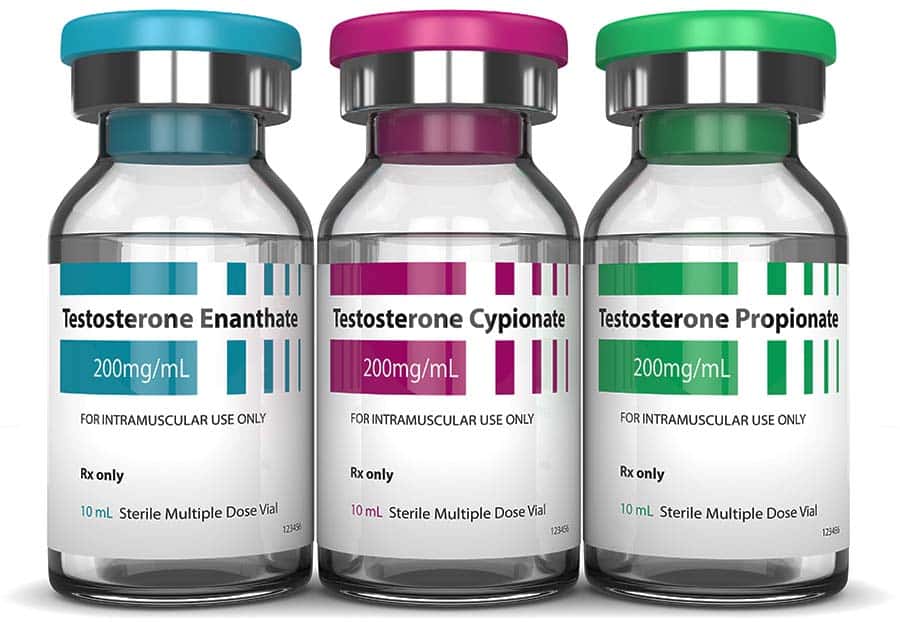Our clinic provides testosterone injections for patients with low testosterone (T) levels and related symptoms. The symptoms of low T often involve a debilitating decrease in sexual function and quality of life. Long-term health problems may include osteoporosis and diabetes.
We do not prescribe and sell testosterone injections or other forms of TRT to people with normal T levels, including bodybuilders, athletes, or other users without any medical indications.
The FDA-approved products we provide guarantee a safe and effective testosterone replacement therapy (TRT). Make sure to avoid non-certified products which are sold without a prescription.
Despite their cheaper price, such products are not a subject of regulation and often contain unknown substances or contaminants.
What are testosterone injections used for?
Testosterone injections are used to treat the symptoms of low T. When your body can’t produce enough of this hormone, this leads to a condition called hypogonadism.
There are two main types of hypogonadism – primary and secondary. Primary hypogonadism is caused by damage to the testicles (infection, trauma, etc.) while secondary is related to pituitary dysfunction. The lack of stimuli to the testicles eventually leads to atrophy.
Both types of hypogonadism and their symptoms can be successfully managed via testosterone injections
There are other effective types of TRT as well, but injections are the widely preferred choice amongst medical doctors and endocrine specialists. That’s because testosterone injections have a number of advantages over other forms of TRT:
- Easier to dose
- Quicker raise in T levels
- Reliable and predictable changes in T
- Better bioavailability
Besides, testosterone injections have a favorable safety profile. In comparison to oral forms, injections are not metabolized in the liver and thus they carry no risk for liver damage.
Furthermore, there is a lower risk for infection in contrast to implanting testosterone pellets. And unlike testosterone gels, the use of injections carries no risk for drug transfer during skin-to-skin contact with someone.
What effects can you expect?
Testosterone injections can help you manage all symptoms of hypogonadism with the exception of infertility.
Scientific studies prove that TRT is effective and the first benefits occur after 3-4 weeks of therapy. They include increased sexual desire, antidepressant effects, and better quality of life. These results continue to improve in the following weeks of TRT.
After 3 months of therapy you can also expect better erectile function, fat loss, increased muscle mass and strength, improved lipid profile, and increased insulin sensitivity.
It takes 6-12 months to reach the maximum of these benefits
Increased bone mineral density and anti-osteoporosis effect occur after at least 6 months of continuous therapy and it takes up to 3 years to reach maximum results of testosterone therapy.
The risk of side effects depends on individual predisposition, comorbidities, and dosage. An experienced medical doctor will adjust your dosage and monitor your therapy which will minimize the theoretical risk for adverse events.
The most common adverse reactions occur after 3-6 months of therapy and include an increase in hemoglobin and hematocrit levels, prostate enlargement, oily skin, and acne.
In addition, TRT suppresses the endogenous production of testosterone which can lead to reduced spermatogenesis and infertility. The effect can be reduced or prevented with medications such as human chorionic gonadotropin (hCG).
This hormone ensures normal LH production and testicular stimulation which preserves fertility.
How to get testosterone injections
Testosterone is an anabolic hormone and as such, it is a strictly controlled substance. Thus, you need to get a testosterone prescription from a medical doctor before purchasing testosterone injections. As a patient, you can receive a prescription only if you have a diagnosis of hypogonadism.
The diagnostic process involves specific diagnostic tests and an assessment of your symptoms. If your total T level is under 300 ng/dl in two separate morning measurements, this strongly suggests that you have hypogonadism.
Your doctor might decide to run additional tests, such as measuring your luteinizing hormone, follicle-stimulating hormone, red blood cell count, protein-specific antigen, etc. to identify the type of hypogonadism and possible contraindications for TRT.
Avoid purchasing testosterone products from sellers and websites which do not require a prescription. Those products are not approved by the FDA. Due to the lack of control, they are often tempered with and their exact contents are unknown.
What products for low T we provide
Our clinic provides testosterone injections that are approved by the FDA, such as testosterone undecanoate, enanthate, and cypionate.
They are all testosterone esters in solutions with oils so intravascular injections are dangerous and must be avoided. Instead, most testosterone injections are intramuscular.
If the injection is given by your doctor, it should be applied to the gluteal muscle. If you are allowed to self-inject, then the most convenient injection site is usually the thigh muscle.
Testosterone Undecanoate comes as intramuscular injections. The recommended dosage is 750 to 1000mg, followed by another dose after 4 to 6 weeks in order to initiate the quick raise of T levels back to the normal range. Then the product must be applied once every 10 to 12 weeks.
Testosterone Cypionate injections have a shorter elimination half-life which is why they should be applied once every 1 to 4 weeks. Recommended doses are 50 to 400 mg, intramuscularly.
Testosterone Enanthate can be applied as either subcutaneous or intramuscular injections. The suggested dosage is 50 to 400 mg every 1 to 4 weeks. Subcutaneous injections should be applied in the abdominal region using an autoinjector device.
What to discuss with a doctor before the start?
Notify your doctor if you are planning parenthood in the future. TRT can lead to testicular atrophy and infertility. Once you discontinue the therapy, the endogenous production of testosterone usually returns back to pretreatment levels.
According to studies, more than half of patients recover within the first 6 months, and 90% experience complete recovery within 12 months. The process can be aided by medications such as hCG.
Besides, there are a number of contraindications against testosterone injections and conditions which may become worse during the therapy. Warn your doctor if you have:
- Prostate enlargement
- History of breast or prostate cancer
- Erythrocytosis
- Thrombocytosis
- Sleep apnea
- Congestive heart failure
- Recent myocardial infarction or stroke
- Allergies to medications
Intramuscular injections are contraindicated if you have myopathy or severe muscle atrophy. Injections of any kind should be avoided if you have coagulation problems.
Make sure to share with your doctor about all medications that you are currently taking
TRT might increase your sensitivity to oxyphenbutazone, antidiabetic medications, insulin, and anticoagulants, which will require modifying their dosage. Taking testosterone and corticosteroids increases the risk of edemas.
Your doctor should also stress the importance of regular checkups. A standard TRT requires a control visit every 6 months in order to assess the effectiveness of the therapy, your prostate health, red blood cell count, and any possible side effects.
Get a free consultation with our medical expert for any questions about hormone replacement therapy




